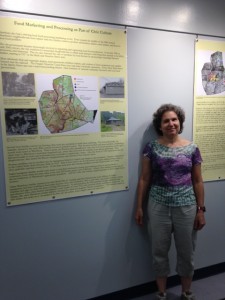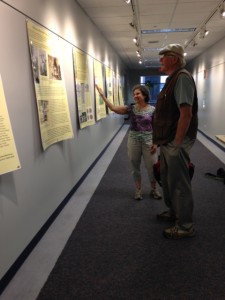
Professor Ruth Glasser and her exhibit Brass City/Grass Roots, on display at the Thomas J. Dodd Research Center in June and July, 2015
Now available in the Dodd Research Center corridor is the exhibit Brass City/Grass Roots, which tells the story of Waterbury, Connecticut’s little known agricultural past.
Created by UConn Assistant Professor in Residence Ruth Glasser, who teaches in the Waterbury campus’s Urban and Community Studies Program, the exhibit boards beautifully detail the rich history of farming in Waterbury, with photographs, quotes from interviews of members of farming families, and historical documents.
The exhibit shows that Waterbury, best known as the “Brass City” due to its wide renown as an industrial center, has had far more farms and farmers than may have been previously supposed. As Dr. Glasser writes in the exhibit: “Farming did not disappear when the first factories started. But farmers have had to constantly reinvent themselves as they faced hilly land, rocky soil, mechanization, and competition in an increasingly tough regional, national, and international market.” Presently the city has a wealth of community gardens and greenhouses, and thousands of vegetables are raised for personal use as well as for soup kitchens.
Dr. Glasser began her research for the project in 2013, when she connected with Sue Pronovost, the Executive Director of Brass City Harvest, a non-profit organization that alleviates food deserts in the city and educates city residents about the legacy of farming and the present opportunities for farming in the city. In her efforts to gather sources for the project Dr. Glasser spoke on local radio programs, gave presentations, and conducted interviews. She conducted extensive research into land records in the town clerk’s office, consulted historical maps, and studied photographs from private collections as well as from such cultural heritage institutions as the Mattatuck Museum, the Connecticut Historical Society, and the Silas Bronson Library. She also was able to access the archive of Waterbury’s local newspaper, the Republican-American.
With funding from the Connecticut Humanities Fund, the Connecticut Community Foundation, and the Waterbury Environmental Benefits Fund, and with the assistance of students in her Historical Methods seminar, Dr. Glasser wrote the exhibit script and captions, chose preferred photographs for the boards, and worked with a designer on the look of the exhibit panels. Last summer the exhibit was shown at local farmers markets, and has been available at UConn’s Torrington and Waterbury campuses.
The exhibit will be up in the corridor until July 31.

